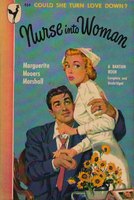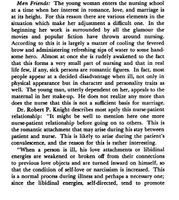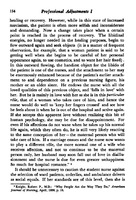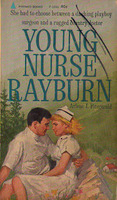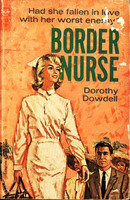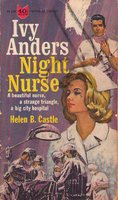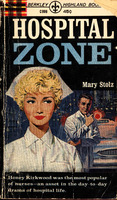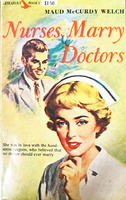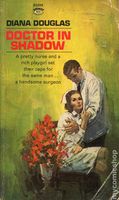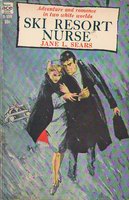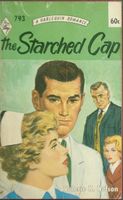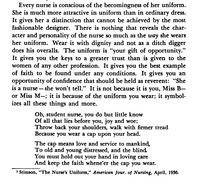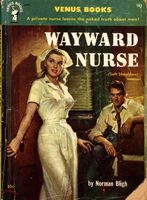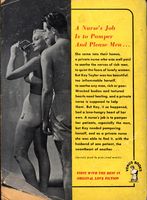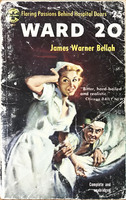Flirtatious Nurses and Husband Hunters
Nursing is intimate; it involves bodily care as well as physical, mental, and emotional vulnerability. Before nursing became an "acceptable" profession for middleclass and upperclass women through the careful social engineering of nursing revolutionaries like Florence Nightingale, women mostly nursed only those in their own family. Public and hospital nursing was performed by those whose reputations could not be harmed by encountering male bodies—that is, men and "women of ill-repute." The idea of a nurse as a woman with alternative motivations, therefore, is not a new phenomenon. Anxious preoccupation with the intimacy involved in nursing has led to various iterations of stereotypes about nurses as being flirtarious, out to snare a husband, or sexually permissive. Nurses have been sexually objectified and the image of the nurse eroticized.
In the early decades of the nurse romance novel craze, authors carefully constructed heroines and protagonists who were "virtuous." Even though she is young, single, and attractive, the main character does not date indiscriminately and in her behaviour with male suitors she conducts herself according to the era's informal codes of socially-appropriate behavior. Her professional character is established by her dismissal of romantic overtures by male patients and doctors.
As American society began to accept more casual dating rituals, nurse-protagonists do too. They enjoy their influence over men, express delight in the romantic attention they receive, and flirt back. In contrast to protagonists of the 1940s and 1950s, who fretted over having accidentally encouraged a man's attention, the nurse-protagonist of the 1960s was happy to let multiple men compete for her time and affection, even when she knew that one or more of her suitors was simply a diversion.
Remember to click each image to open up a lightbox gallery with more examples, cover images, and quotes!
Pursuer or Pursued?
Nurse protagonists in romance novels are frequently described as subject to misguided affection on the part of patients and both subtle and aggressive advances by doctors or hospital adminsitrators. When they are not being pursued, male characters make off-hand comments to one another about the physical appearance of the nurse characters, remarking on their attractiveness moreso than their professional skills. Often, the inner monologues of the protagonist or her dialogue with other female characters reveal that she is aware of and chooses to ignore or dismiss these comments, advances, and affections. Other protagonists express their frustration at being stereotyped and it contributes to their dissatisfaction with men and dating.
The Flirt
Hospital Zone is an interesting study in it's acknowledgement of stereotypes about young nurses and changing social mores about dating practices. Nurse Honey Kirkwood first appears to be the stereotype of an easy nurse and a modern, young woman: when the story begins she is already dating 3 men and then falls for Dr. Dragone. By the end of the story though, Nurse Kirkwood does a complete 180 and decides not to choose any man to settle down with. Instead, she chooses to focus on her own self-growth and career aspirations, "She would not arrive, as she had expected to, at an age, a point in experience, and say, There, that is who I am. She would search and wonder and change and go on, and the search would take up her life. It would be her life. That life itself was the quest was not the answer she'd looked to find, but it was one she was beginning to accept."
On the Hunt
If one were to judge these narratives by their cover captions alone, it would seem that many of the protagonists are after just one thing—a husband. Yet, the captions are misleading. While romantic fulfillment is certainly a defining feature of romance novels, the protagonists are commonly just as concerned about professional fulfillment. In contrast, her antagonists are motivated by romantic envy and even neglect their nursing duties as they strive to disrupt the romantic life of the protagonist while securing a husband for themselves.
Erotic Novels and the Sexy Nurse Image
While sweet category romances were popular with female readers, mass-market publishers encouraged and capitailzed on men's fascination with career girls and nurses by delivering licenstious tales with a nurse theme. Prurient fiction about nurses promised to reveal the "secret lives" of nurses and imagined fantasy scenarios about night duty. Book buyers knew the difference between romances and erotic stories by the taste and style of the cover illustration; steamier tales meant for male audiences signaled their content with voluptuous or scantily-clad women striking a provocative pose, while the sweet romances depicted a pretty and young woman properly dressed, perhaps in a man’s tender embrace.
Critical Thinking Prompts:
-
Does the narrative content of a book outweigh visual or paratextual content? That is, even though the narrative content of romance novels might contradict some of the nurse stereotypes, are the covers and captions impactful enough to still promote them?
-
Why might it have been important to authors that their protagonists were "good girls"? Why not write a character who defies sexual mores? Must a sexualized stereotype always be deemed negative?
-
Are sexualized steretypes a matter of gender inequality? Or, can you think of professions that have been gendered male that similarly have been sexualized by steretyping?

